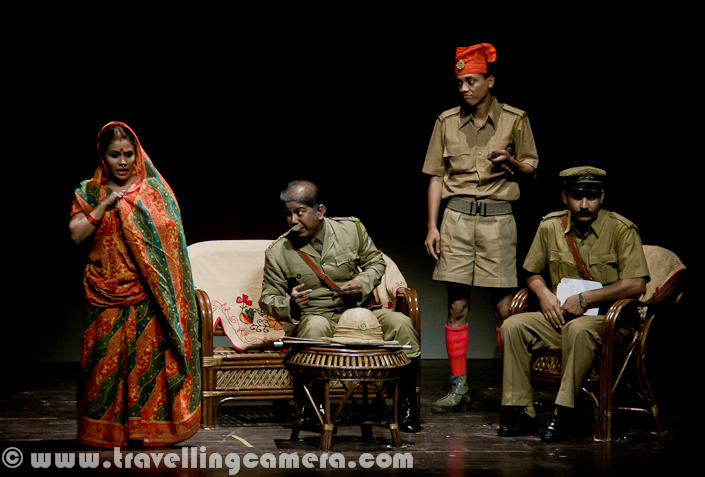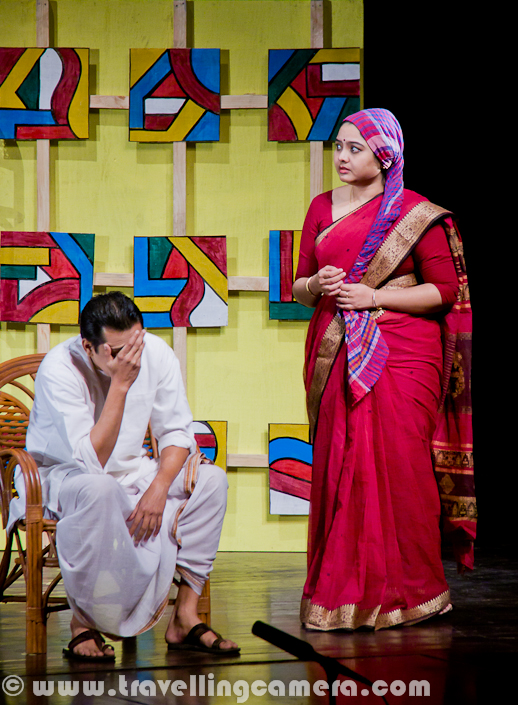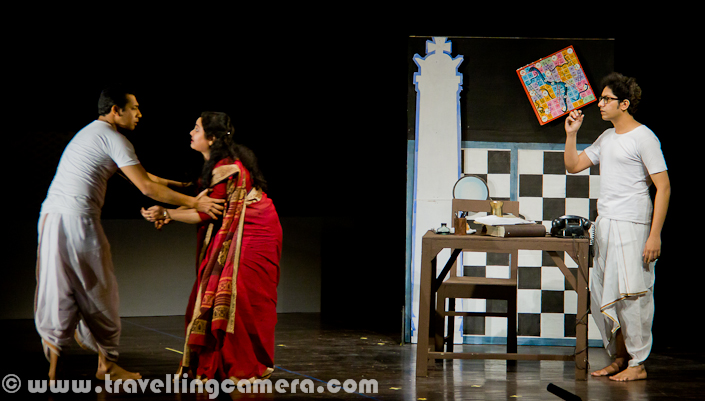Inspired by the fictitious character of Sherlock Holmes, Byomkesh Bakshi was created as the intelligent, mystery-loving and mystery-solving detective of Bengali literature. And most of the folks also relate to Byomtesh as one of the popular Indian Detective, who was seen many times on Doordarshan-1. This is one of the TV-Serials, our generation has seen on DD-1. During childhood Byomkesh was one of the hero and now if we see some of the episodes, it looks like a comedy serial. This play was on same lines, but there were few things which were seriously taken care of.
Once again, let us try to study various techniques, the team has used to tell the story along with the obvious dialogs and gestures. In this picture, for example, the clothes clearly indicate that the officers who are seated are senior to the one who's standing. Of those who are seated, the older one obviously plays at least a part-comic role. The younger officer displays low confidence with his slumped shoulders. the woman by her insistence on not showing her face to the men, shows that she is traditional and orthodoxed. And you can make out all this without hearing any dialogs or reading any background of the play.
The police officer in this scene is threatening the woman and the old man in front and the woman and the old man are suitably scared. The body language of the old man indicates that he is perhaps fearing arrest or even a beating by the policeman. The close proximity of the woman and the old man indicates that they are part of a family.
This, on the other hand, is a more modern family as indicated by the woman's uncovered head. And the body language of the policemen is less aggressive here so this family is either very influential or victims rather than suspects in a crime. Isn't it unbelievable how much you can make out without hearing anything?
In this scene, I sense maniacal tendencies in the man wearing white whereas the holy man - as indicated by his yellow clothes and rudraksh mala - isn't afraid and believes that he has the maniac in his control. The setting reveals simple living. Of course, this may be completely different from what was actually going on on the stage. But we're just making guesses here. :)
The holy man here is eagerly looking for some exciting information in the book. The body language of the woman is not that of a disciple but rather that of a help. And she seems to have a lot on her mind. She seems to know something the holy man doesn't.
Now this frame is rather interesting. It seems that their regular day-to-day activities have been disrupted by some disastrous event or news as depicted by the woman's washed hair and the man's head in his hand.
Now here are three men, brothers possibly. One of them is recovering from an accident and is trying to get back on his feet. The man on the left is encouraging him but the man on the right is unconcerned and deep into his books. The man on the left is addicted to tobacco. These might be very important clues for a detective. :)
In this frame, the man has obviously recovered and is well enough to play a violin. I don't know what to make of this though. :)
The human interactions as well as the setting in this scene is interesting. The woman has obviously just been stopped from touching the man's feet. It seems that she was trying to thank him for something. Whereas the man seems to feel "Yeh to mera farz tha." The setting - the chess board and the snakes and ladders board in the background - indicates games and schemes. There's something fishy going on here.
See if you canore of the story using only these photographs and feel free to leave comments if you can. :)











.jpg)
Comments